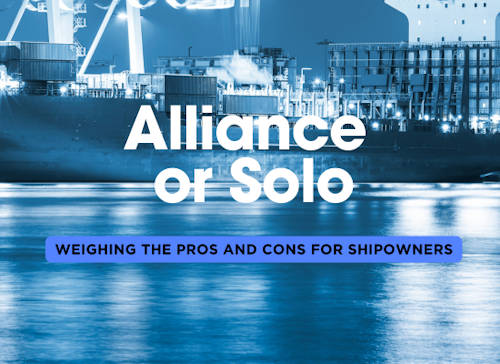Joining a Shipping Alliance vs. Going Solo: Pros and Cons for Shipowners

When it comes to managing a fleet of ships, shipowners are often faced with a critical decision: should they operate independently or join a maritime alliance? Both options come with unique benefits and challenges. Independent ship ownership offers autonomy and control, but with greater costs and responsibilities. On the other hand, joining an alliance can open doors to cost savings, shared resources, and expanded market reach, but may limit flexibility. In this article, we’ll explore the key differences between private ship ownership and joining an alliance, looking at cost efficiency, market reach, risk management, and more, to help shipowners make the best decision for their business.
Are There Alternatives to Major Alliances?
For smaller shipowners or those who don’t meet the criteria of larger alliances, there are alternatives such as:
- Partnership Agreements: Shipowners can form smaller partnerships or joint ventures to share routes, operational costs, and resources without joining a formal alliance.
- Regional or Niche Alliances: Some shipowners may find success in regional alliances that focus on smaller or specialized markets, such as short-sea shipping or niche cargo.
- Consortia: These are similar to alliances but may involve temporary collaborations on specific routes or services, offering flexibility for smaller operators.
** The data in these tables contain rough estimates.
Cost Efficiency: Independent vs. Alliance Costs
One of the most significant factors when choosing between private ship ownership and joining an alliance is cost efficiency. Managing a ship comes with hefty expenses, from fuel and maintenance to administrative overhead. While independent shipowners shoulder these costs entirely, alliances can provide relief through collective bargaining power, reducing fuel and maintenance costs significantly. But how much can you really save by joining an alliance? Let’s break down the numbers and see how operating costs compare between going solo and teaming up with others.
| ShipUniverse: Cost Efficiency - Independent vs. Alliance Costs | |||||
| Cost Component | Private Ship Ownership | Alliance Member | Potential Savings with Alliance | Collective Bargaining Power (Yes/No) | |
| Fuel Costs (per year) | $2,000,000 - $3,000,000 | $1,200,000 - $2,000,000 | Up to 40% | Yes | |
| Maintenance Costs (per year) | $500,000 - $1,200,000 | $300,000 - $800,000 | Up to 33% | Yes | |
| Administrative Overhead | $250,000 - $500,000 | $100,000 - $300,000 | Up to 40% | Yes | |
| Insurance Premiums | $150,000 - $400,000 | $100,000 - $250,000 | Up to 30% | Yes | |
| Port Fees (per year) | $300,000 - $500,000 | $200,000 - $400,000 | Up to 25% | Yes | |
| Crew Wages and Benefits (per year) | $800,000 - $1,500,000 | $700,000 - $1,200,000 | Up to 20% | No | |
| Legal & Compliance Costs (per year) | $50,000 - $200,000 | $30,000 - $150,000 | Up to 25% | Yes | |
| Marketing & Business Development | $100,000 - $300,000 | $50,000 - $150,000 | Up to 50% | Yes | |
Market Reach and Cargo Volume: Independent vs. Alliance Opportunities
One of the most compelling reasons for joining a maritime alliance is the enhanced market reach and cargo volume potential. Independent shipowners often face limitations in accessing major global shipping routes and high-volume cargo opportunities due to competition and limited port access. However, joining an alliance can open up new shipping routes, provide better access to key ports, and significantly increase cargo volume handled annually. Let’s dive into how independent operations compare to alliances when it comes to expanding market reach and handling cargo volume, with a breakdown of the advantages alliances offer in terms of global exposure.
| ShipUniverse: Market Reach and Cargo Volume - Independent vs. Alliance Opportunities | ||||||
| Ownership Type | Global Market Reach (Regions) | Number of Shipping Routes | Access to Major Ports (Yes/No) | Contract Negotiation Power | Average Cargo Turnaround Time (days) | Access to Emerging Markets (Yes/No) |
| Private Ship Ownership | 2-4 Regions | 15-25 Routes | Limited Access | Low | 5-7 Days | No |
| Alliance Member | 5-7 Regions | 50-100 Routes | Full Access | High | 2-4 Days | Yes |
Risk Management and Liability Sharing: Independent vs. Alliance
Running a ship involves significant risks, from environmental incidents to crew injuries and cargo liabilities. For independent shipowners, handling these risks alone can be both costly and stressful. However, joining an alliance can significantly reduce this burden through liability sharing and collective risk management strategies. Alliances often offer shared insurance, crisis management, and access to better legal resources, making it easier for shipowners to navigate unforeseen issues. In this section, we'll explore how risk management and liability differ between private ship ownership and membership in an alliance, and how joining an alliance can mitigate financial exposure.
| ShipUniverse: Risk Management and Liability Sharing - Independent vs. Alliance | |||||
| Ownership Type | Insurance Premiums (per year) | Liability Sharing (Yes/No) | Crisis Management Support | Environmental Compliance Costs | Incident Response Speed |
| Private Ship Ownership | $150,000 - $400,000 | No | None (Independent) | $50,000 - $150,000 | Slower (due to lack of centralized resources) |
| Alliance Member | $100,000 - $250,000 | Yes | Full support from alliance network | $30,000 - $100,000 | Faster (centralized crisis management resources) |
Flexibility and Decision-Making: Private vs. Alliance
Flexibility and speed in decision-making are crucial for managing a ship or fleet. Independent shipowners enjoy complete control over their operations, giving them the flexibility to make quick decisions without needing to consult others. On the flip side, joining an alliance brings numerous advantages, but decision-making can be slower and more complex due to the need for consensus. In this section, we’ll compare the operational flexibility and decision-making processes for private shipowners versus alliance members, and how these factors affect business agility.
| ShipUniverse: Flexibility and Decision-Making - Private vs. Alliance | |||||
| Ownership Type | Decision-Making Speed | Flexibility in Routes | Autonomy in Operations (High/Medium/Low) | Need for Consensus (Yes/No) | Ability to Adapt to Market Changes |
| Private Ship Ownership | Fast | High | High | No | Very High |
| Alliance Member | Medium to Slow | Medium | Low to Medium | Yes | Moderate |
Profitability: Solo Profit vs. Shared Profits in an Alliance
Profitability is at the core of any shipowner's decision-making process. When operating independently, shipowners retain all the profits but also bear all the risks and expenses. Joining an alliance, however, means sharing profits with other members, but it also comes with access to reduced operational costs, larger contracts, and potentially higher revenues due to the collective power of the group. In this section, we’ll explore how profitability compares between private ship ownership and joining an alliance, weighing the benefits of full profit retention versus shared income with reduced costs.
| ShipUniverse: Profitability - Solo Profit vs. Shared Profits in an Alliance | |||||
| Ownership Type | Profit Retention (%) | Revenue Sharing (Alliance Only) | Gross Profit (per year) | Net Profit After Expenses (per year) | Risk Exposure |
| Private Ship Ownership | 100% | N/A | $10M - $50M | $5M - $20M | High |
| Alliance Member | 50% - 70% | Yes | $30M - $80M | $15M - $40M | Low to Moderate |
Choosing between private ship ownership and joining an alliance is a significant decision for any shipowner, as both paths come with their own set of advantages and challenges. Here’s a breakdown of the pros and cons to help you evaluate which option might best suit your operational goals, risk tolerance, and financial priorities.
Summary
Private Ship Ownership: Pros and Cons
Pros of Private Ship Ownership 🏆
- Full Control: As a private shipowner, you have complete autonomy over your operations. You can decide your routes, schedules, contracts, and business strategies without needing to consult anyone else. This flexibility allows for quick decision-making and the ability to rapidly respond to market changes.
- 100% Profit Retention: You keep all the profits from your operations, with no need to share revenue with alliance members. This can result in higher earnings per voyage, especially when business is good.
- Operational Flexibility: Private ownership offers the freedom to adapt routes, services, and strategies to match specific needs or market trends. This flexibility can be a significant advantage in volatile markets.
- Personal Branding: Operating independently allows you to build your own brand reputation in the industry. This is particularly beneficial if you’re looking to carve out a niche or establish a strong, personal connection with clients.
Cons of Private Ship Ownership ⚠️
- Higher Costs: Without the benefits of group buying or shared resources, private shipowners face higher fuel, maintenance, and administrative costs. This can significantly reduce profit margins, particularly when operating in competitive or high-cost environments.
- Greater Risk Exposure: As the sole operator, you bear all the financial risks associated with your ships. If something goes wrong—such as a major incident or market downturn—you’re responsible for the full financial impact, which can be devastating.
- Limited Market Reach: Private owners typically have less access to major shipping routes and emerging markets, making it harder to compete with larger players who have a global presence.
- Fewer Negotiation Benefits: Without the bargaining power of an alliance, private shipowners may struggle to secure favorable contracts, lower insurance premiums, or discounts on fuel and other operational costs.
Joining an Alliance: Pros and Cons
Pros of Joining an Alliance 🏅
- Cost Efficiency: Being part of an alliance means shared resources and the ability to leverage collective bargaining power. Alliance members benefit from lower fuel costs, reduced maintenance fees, and shared administrative overhead, significantly reducing the overall cost of operations.
- Increased Market Reach: Alliances provide access to more shipping routes and major global ports, allowing members to expand their market reach and handle higher cargo volumes. This can lead to larger contracts and increased profitability.
- Shared Risk: By joining an alliance, you benefit from liability sharing and risk management support. This reduces your financial exposure in the event of accidents, environmental incidents, or market volatility.
- Crisis Management and Support: Alliances often offer centralized crisis management, ensuring quicker response times and access to expert support when incidents occur. This provides peace of mind and operational continuity in challenging situations.
- Access to Emerging Markets: Alliances often have the infrastructure and connections to give members access to new and emerging markets, increasing the opportunities for growth and expansion.
Cons of Joining an Alliance ⚠️
- Profit Sharing: One of the biggest downsides to joining an alliance is that profits are shared among members. While you may benefit from reduced costs, you’ll also need to give up a portion of your revenue to the alliance.
- Slower Decision-Making: Because alliances require group consensus, decision-making can be slower and more cumbersome compared to private ownership. This could delay critical operational decisions or limit flexibility when adapting to market changes.
- Reduced Autonomy: Operating within an alliance means you have less control over certain aspects of your business. Routes, schedules, and even business strategies may need to align with the alliance’s goals, reducing your ability to operate independently.
- Loss of Individual Branding: In an alliance, your personal brand may become secondary to the larger group’s identity. While this isn’t always a bad thing, it can be a disadvantage for shipowners looking to build a unique reputation or differentiate themselves in the market.
When deciding between private ship ownership and joining an alliance, it’s important to weigh the trade-offs. Private ship ownership offers full control, profit retention, and operational freedom, but comes with higher costs and greater risk exposure. On the other hand, joining an alliance provides access to larger markets, cost efficiencies, and shared risk, but requires giving up some control and sharing profits.
The choice ultimately depends on your business goals, risk tolerance, and desire for autonomy. For shipowners looking to maximize flexibility and retain full profits, private ownership may be the way to go. However, for those seeking to reduce costs, expand market reach, and mitigate risk, joining an alliance could offer substantial benefits.

Do you have a Maritime Product or Service that may be of interest to Shipowners? Tell us about it here!
Do you have feedback or insights? Please reach out to editor @ shipuniverse.com



